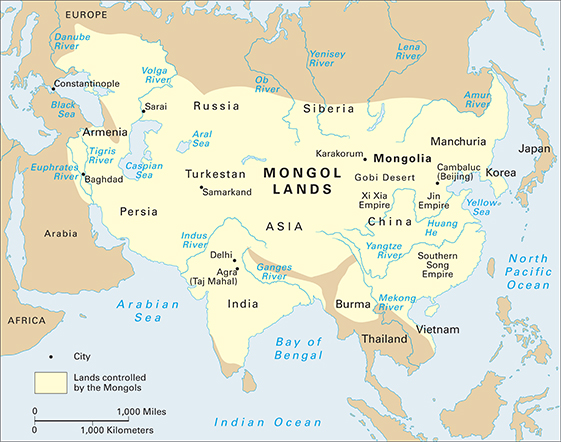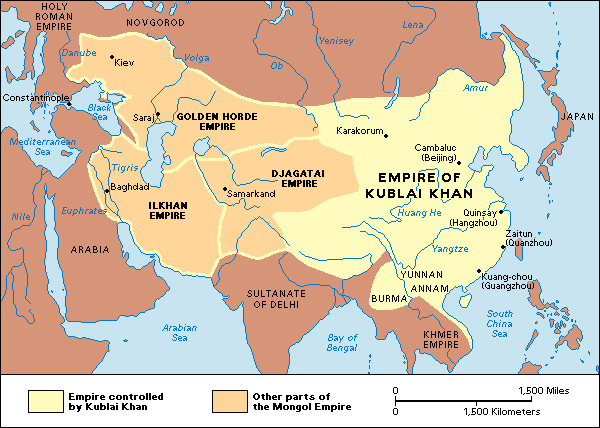Mongol Empire was the biggest land empire in history. Its territory extended from the Yellow Sea in eastern Asia to the borders of eastern Europe. At various times, it included Armenia, China, Korea (now North Korea and South Korea), Mongolia, Persia (now Iran), and Turkestan. It also included parts of Burma (now Myanmar), Russia, Siam (now Thailand), and Vietnam.

The Mongols, who eventually became known as the Tatars, were the most savage conquerors of history. But this vast empire helped increase contacts between peoples of different cultures. Migrations fostered these contacts and promoted trade. Roads were built to connect Russia and Persia with eastern Asia. Many Europeans came to China, and Chinese went to Russia and other parts of Europe. Printing and other Chinese inventions such as paper, gunpowder, and the compass may have been introduced to the West during Mongol times.
The Mongols originally consisted of loosely organized nomadic tribes in Manchuria, Mongolia, and Siberia. They lived in felt tents called yurts and raised camels, goats, horses, oxen, and sheep. They ate mainly meat and milk. Every Mongol man was a soldier and learned to ride and use a bow and arrow skillfully.
Early empire
Genghis Khan.
In the late 1100’s, Temujin, a Mongol chieftain who later became known as Genghis Khan, rose to power as khan. He began to unify and organize the scattered Mongol and other nomadic tribes into a superior fighting force. Genghis Khan was shrewd, ruthless, ambitious, and a strict disciplinarian. After he became the undisputed master of Mongolia, and “lord of all the peoples dwelling in felt tents,” he set out on a spectacular career of conquest. 
Genghis Khan aimed to train the best-disciplined and most effective army of his time. As part of his military strategy, he formed an officer corps from Mongols who were trained in military tactics. These men were then stationed with various tribes as a training force. The Mongol tribes specialized in the art of siege. They used storming ladders and sandbags to fill in moats. Besiegers approached fortress walls under the protection of gigantic shields. Each tribe prepared a siege train, which consisted of special arms and equipment.
Invasions.
Genghis Khan wanted to conquer China. He attacked first Xi Xia, a state along the northwestern border of China. Xi Xia represented the Chinese military pattern, with Chinese-trained armies and Chinese-built fortresses. In this campaign, Genghis Khan could evaluate his armies and train them for war against China.
The Mongols subdued Xi Xia and then turned to northeastern China. There the Ruzhen (also known as Jurchen) people from northeast China had established the Jin dynasty. Genghis Khan chose spring for his assault on China, so that his horses would have food when crossing the desert known as the Gobi. Warriors carried everything they needed on the march, and each rider had a spare horse. The hordes drove herds of cattle for food in the desert. The Mongol conquest of all of northern China took several decades. It was not completed until 1234, after Genghis Khan’s death.
In 1218, Genghis Khan broke off his attack on China and turned west toward central Asia and eastern Europe. His armies charged into the steppes of Russia and the Muslim lands, including Persia. They came within reach of Constantinople (now Istanbul) and destroyed much of Islamic–Arabic civilization.
All along their routes, the Mongol armies ruthlessly eliminated any resistance. They spread terror and destruction everywhere. When conquered territories resisted, the Mongols slaughtered the population of entire cities.
Genghis Khan died in 1227. The Mongols pushed into Europe under Ogotai, a son of Genghis Khan. In 1241, about 150,000 Mongol riders laid waste a large part of Hungary and Poland, threatening the civilization of western Europe. Ogotai died in the midst of this campaign. His death forced the Mongol generals to break off the campaign and return to Mongolia to elect a new khan.
Later empire
Kublai Khan,
a grandson of Genghis Khan, completed the conquest of China in 1279, after attacking the Southern Song dynasty that ruled southern China. Kublai Khan’s Yuan dynasty lasted until 1368. He established the Mongol winter capital at Cambaluc (also spelled Khanbalikh), the site of present-day Beijing. Further attempts to extend the Mongol Empire to Japan were unsuccessful. Mongol warriors fought unsuccessfully at sea and in the tropical climate of Southeast Asia. 
The Mongols under Kublai Khan had a reputation for greater tolerance than that shown under earlier Mongol rulers. He permitted the existence of various religions and enlisted the services of Buddhists, Christians, Muslims, and Taoists. He supported Confucianism and Chinese political ideas, though he avoided having too many Chinese in high offices. In Persia and other Islamic lands, many Mongols adopted Muslim customs and the Muslim faith.
European contacts.
Marco Polo was one of the most famous Europeans to travel to the Orient at this time. His travel records contain much interesting information about the Mongols. His reports of beautiful Chinese cities and the riches of the country Europeans called Cathay did much to arouse the interest of Europeans in exploring the possibilities of trade with the Orient. Many Europeans, including Christopher Columbus, then sought to go to the Orient by the sea route.
Kublai Khan expressed a desire to have more missionaries sent to China. Dominican and Franciscan missionaries were welcomed by the Khan in Cambaluc. A Franciscan, John of Montecorvino, built a church in the capital and converted many people to Christianity.
Decline.
The Mongol Empire did not last long, because it was too big and had no unity of culture. Actually, it began to disintegrate shortly after it reached its peak of expansion in the late 1200’s. The Mongols were dauntless fighters, but had little experience in administration. They relied upon other peoples to look after their affairs. They brought foreigners into China to avoid total reliance on the Chinese. The Mongols temporarily suspended the Chinese civil service system to allow these other peoples to assume positions.
Corrupt government and incompetent administration resulted in revolts in different parts of the empire. Even before the fall of the Yuan dynasty in China, the Mongols had lost control of many of their conquered lands. In some areas, they had never succeeded in firmly establishing their rule after their military conquests. Even at the peak of his power, Kublai Khan’s authority did not extend to such distant places as Persia and Russia. The Mongols also lacked a firm hold in Southeast Asia.
Breakup.
When Kublai Khan died, his empire broke up into several parts. These smaller empires were the Golden Horde on the steppes of southern Russia and the Balkans, the Mongolian-Chinese Yuan Empire, and the realm of the Ilkhans in western Asia. A revolution in China in the 1300’s ended the Yuan dynasty and restored Chinese rule in the form of the Ming dynasty.
The great Timur, or Tamerlane, a descendant of Genghis Khan, combined some Mongol empires and extended his rule over much of Asia in the late 1300’s. A descendant of Timur named Babur established a powerful Mongol state in India in 1526. Babur’s realm was called the Kingdom of the Great Mughals. The term Mughal comes from the Persian word mughul, meaning a Mongol. A Mughal emperor, Shah Jahan, built the beautiful Taj Mahal in the early 1600’s. The British destroyed the Mughal kingdom after it had begun to break up in the 1700’s.
